Internals I
Suitably impressive from the outside and bundle points of view. Can the internals keep up the good work ?.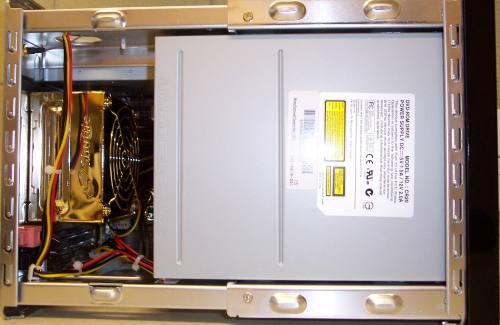
That's the first vista after opening up the chassis. A note about the DVD-ROM drive here. It's incessantly loud when reading discs. Playing the Shuttle promotional CD, for example, caused it to spin at full speed during the entire sequence. It seems to do this with every CD / DVD tested. The XPC line goes to painstaking lengths to reduce the overall sound profile down, including using smart fans, low-noise PSUs and the like. The DVD-ROM seems to slap Shuttle's efforts firmly in the face. Just for this reason alone, we'd look towards changing it for a quieter model. That's a shame, really. The tray that holds the various drives and reader is removed via two small holding screws on each side.
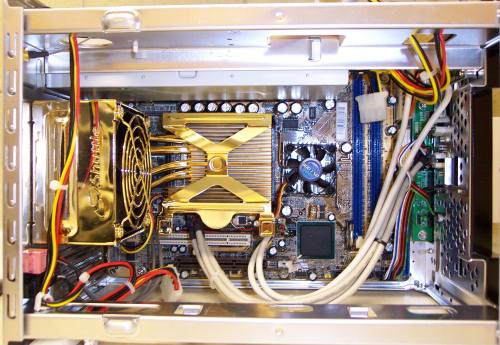
Notice another difference from other XPCs ?. The cooler, holding clip, and fan surround have had the designer touch. They're now gold in colour and either look gaudy or excellent; I can't make up my mind as to which it is. There's a reasonable amount of room to work with, but like any other small form-factor system, you need to exercise patience and due care to attention. It's all to easy to become riled when things aren't quite fitting as you had hoped.
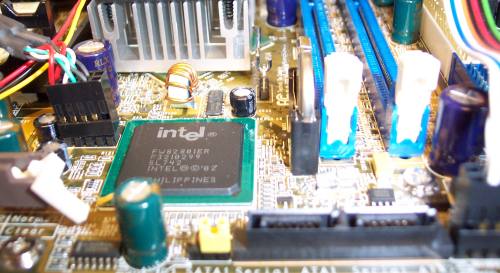
Intel's flagship ICH5R Southbridge takes pride of place in the above shot. It can natively run 8 USB2.0 ports (it needs them in this instance), a couple of IDE channels with up to ATA100 speeds, and 2 SATA drives in either independent, RAID0 and RAID1 formats. You can see them at the very front of the shot. The vertically-mounted battery is a neat touch. 2 DIMM slots afford dual-channel operation on this i865G chipset. The Northbridge is hidden under a small and annoying fan. It also includes Intel's beleaguered Extreme Graphics 2. Most of the front-mounted functions attach on to the FB61 motherboard via thick wires. Those make it a pain to install the primary and secondary IDE cables. There just isn't enough room to do it easily. Removing the cable's headers first causes the problems of trying to re-insert them over the IDE cables later. Just this fact alone can escalate into a hair-pulling session. I really can't quite see why Shuttle can't follow Biostar's lead and have the various drive cables pre-attached. It would make life that much easier for the builder.
Plugs-wise, there's a single SATA power connector bundled in with a single, standard molex and floppy drive connectors on the right-hand side. That's fine because the drives will invariably use the two molex and single floppy connector on the left side of the board.
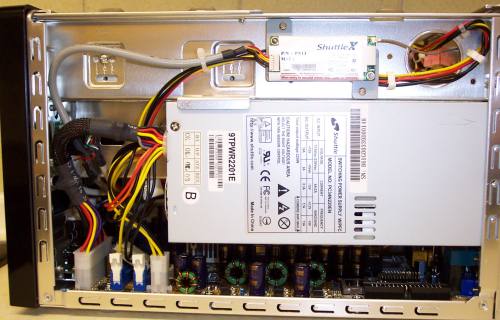
The other side houses a 220w near-silent PSU, the floppy port in the Shuttle's strange location, and the Wireless module that provides the brains for the antenna. The PSU provides an adequate 16A on the 12v line and lives up to its near-silent tag.
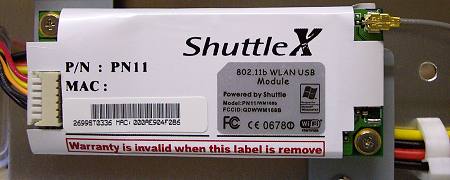
If you think you've seen it before in a HEXUS review, you'd be correct. It's the same PN11 module as found on the SB65G2. That infers 802.11b operation and Shuttle's PRISM software. We tested it with an iNexQ Wireless Access Point and internal server setup. There were no problems in connecting it immediately. The PRISM software had this to report.
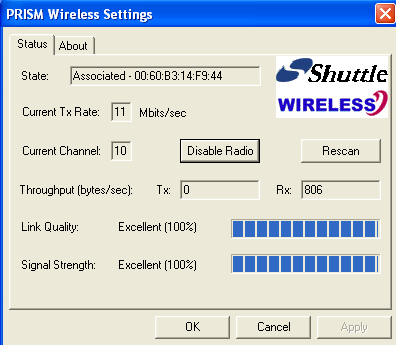
An excellent connection status from over 20 feet away. A thick intervening wall made the connection all that much more impressive. A 54g module would have been nicer, but we guess it would push up the cost of the package, something that Shuttle needs to keep a careful financial eye on.

The Serious Sam 2 benchmark was transferred over from a PC acting as a server. The transfer rate steadied at around 560KBps, which translates to around 4.5MBit/s. That's about par for 802.11b. The connection was stable from over 50 feet and 3 walls away, although the overall transfer speed dropped, which was expected. A notable, useful extra.









